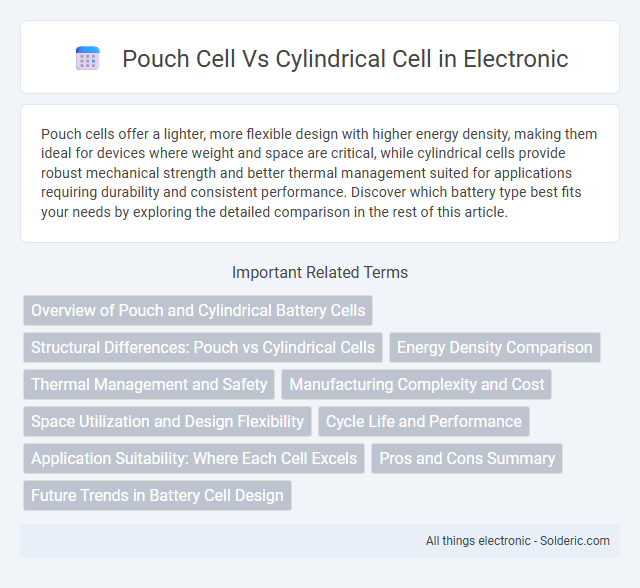Pouch cells offer a lighter, more flexible design with higher energy density, making them ideal for devices where weight and space are critical, while cylindrical cells provide robust mechanical strength and better thermal management suited for applications requiring durability and consistent performance. Discover which battery type best fits your needs by exploring the detailed comparison in the rest of this article.
Comparison Table
| Feature | Pouch Cell | Cylindrical Cell |
|---|---|---|
| Shape | Flat, flexible pouch | Rigid cylindrical tube |
| Energy Density | Higher volumetric energy density | Moderate volumetric energy density |
| Weight | Lighter due to flexible packaging | Heavier with metal casing |
| Thermal Management | Less efficient cooling | Better heat dissipation |
| Durability | Less mechanically robust | More durable, withstands impact |
| Cost | Generally costlier | Lower manufacturing cost |
| Applications | Consumer electronics, electric vehicles | Power tools, electric vehicles, energy storage |
Overview of Pouch and Cylindrical Battery Cells
Pouch cells feature a flexible, lightweight design with a laminated polymer exterior, allowing for custom shapes and higher energy density in compact spaces. Cylindrical cells utilize a rigid metal casing, offering robust mechanical stability, efficient heat dissipation, and ease of manufacturing scalability. Both cell types are widely used in electric vehicles and portable electronics, with pouch cells favoring space optimization and cylindrical cells excelling in durability and thermal management.
Structural Differences: Pouch vs Cylindrical Cells
Pouch cells feature a flexible, lightweight aluminum laminated film casing that allows for compact, space-efficient designs, while cylindrical cells use rigid metal casings with a uniform cylindrical shape for enhanced mechanical stability. The pouch design enables better heat dissipation due to its flat surface, whereas cylindrical cells often incorporate venting mechanisms to manage internal pressure. Your choice between these formats can impact battery pack integration, thermal management, and overall device form factor.
Energy Density Comparison
Pouch cells typically offer higher energy density than cylindrical cells due to their flexible packaging and reduced internal space for non-active materials. The flat design of pouch cells allows for more efficient stacking and better utilization of volume, resulting in superior gravimetric and volumetric energy density. Cylindrical cells, while robust and easier to manufacture, generally have lower energy density as their cylindrical shape leads to less optimized internal space usage.
Thermal Management and Safety
Pouch cells offer superior thermal management due to their flat design, enabling better heat dissipation and uniform temperature distribution compared to cylindrical cells, which often suffer from uneven heat buildup in their cylindrical core. Cylindrical cells are typically more robust under mechanical stress, providing enhanced safety against swelling and deformation, but their metal casing can trap heat, increasing the risk of thermal runaway. If your application requires efficient cooling and compact layouts, pouch cells may better protect your device by minimizing hotspot formation and improving overall safety.
Manufacturing Complexity and Cost
Pouch cells feature a flexible, laminated packaging that simplifies manufacturing by reducing the number of components and enabling faster assembly, resulting in lower production costs compared to cylindrical cells. Cylindrical cells require metal casing and more intricate sealing processes, increasing material usage and manufacturing complexity, which elevates their overall cost. The streamlined design of pouch cells supports scalability and cost efficiency, making them favorable for applications prioritizing lightweight and compact energy storage solutions.
Space Utilization and Design Flexibility
Pouch cells offer superior space utilization due to their flat, flexible design, allowing for efficient packing and higher energy density within limited spaces. Cylindrical cells, with rigid metal casings, provide less design flexibility but benefit from structural robustness and easier thermal management. Your choice depends on whether compactness and adaptable form factors outweigh the enhanced durability and cooling advantages of cylindrical cells.
Cycle Life and Performance
Pouch cells generally offer higher energy density and better thermal management, leading to improved cycle life under controlled conditions compared to cylindrical cells. Cylindrical cells are known for their mechanical robustness and consistent performance, often providing longer cycle life in high-drain applications due to their solid casing and efficient heat dissipation. Performance variations depend on the specific chemistry and application, with pouch cells favored in flexible designs and cylindrical cells in durability-focused uses.
Application Suitability: Where Each Cell Excels
Pouch cells excel in applications requiring lightweight, flexible battery designs such as drones, electric vehicles, and wearable devices due to their high energy density and customizable shapes. Cylindrical cells are ideal for high durability and thermal management in power tools, laptops, and electric bikes, offering robust mechanical stability and ease of manufacturing. Your choice depends on balancing space constraints, energy needs, and specific device requirements to maximize performance and longevity.
Pros and Cons Summary
Pouch cells offer high energy density and flexible shapes, making them ideal for compact designs, but they are more susceptible to swelling and mechanical damage compared to cylindrical cells. Cylindrical cells provide robust structural integrity, better thermal management, and ease of manufacturing, though they typically have lower energy density and take up more space. Understanding these differences helps you select the right cell type for your device's performance and durability needs.
Future Trends in Battery Cell Design
Pouch cells are gaining traction in electric vehicle and portable electronics markets due to their lightweight, flexible design, and high energy density, enabling more efficient space utilization and thermal management. Cylindrical cells continue to dominate with robust mechanical stability and scalability in production, favored for applications demanding long cycle life and safety, such as power tools and energy storage systems. Emerging trends indicate a hybrid approach integrating pouch and cylindrical cell advantages, alongside advancements in solid-state electrolytes and electrode materials, aiming to enhance energy density, safety, and fast-charging capabilities across industries.
Pouch cell vs Cylindrical cell Infographic

 solderic.com
solderic.com